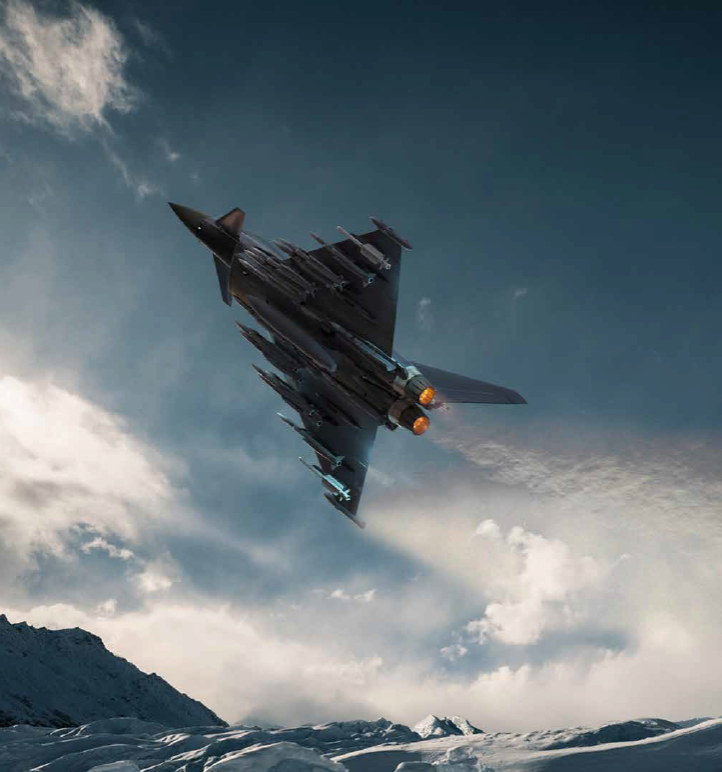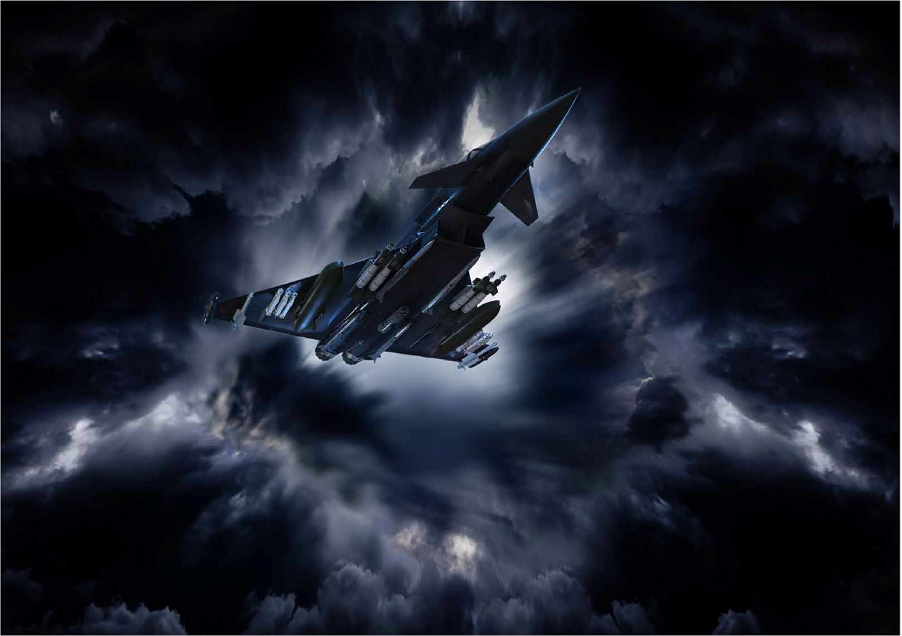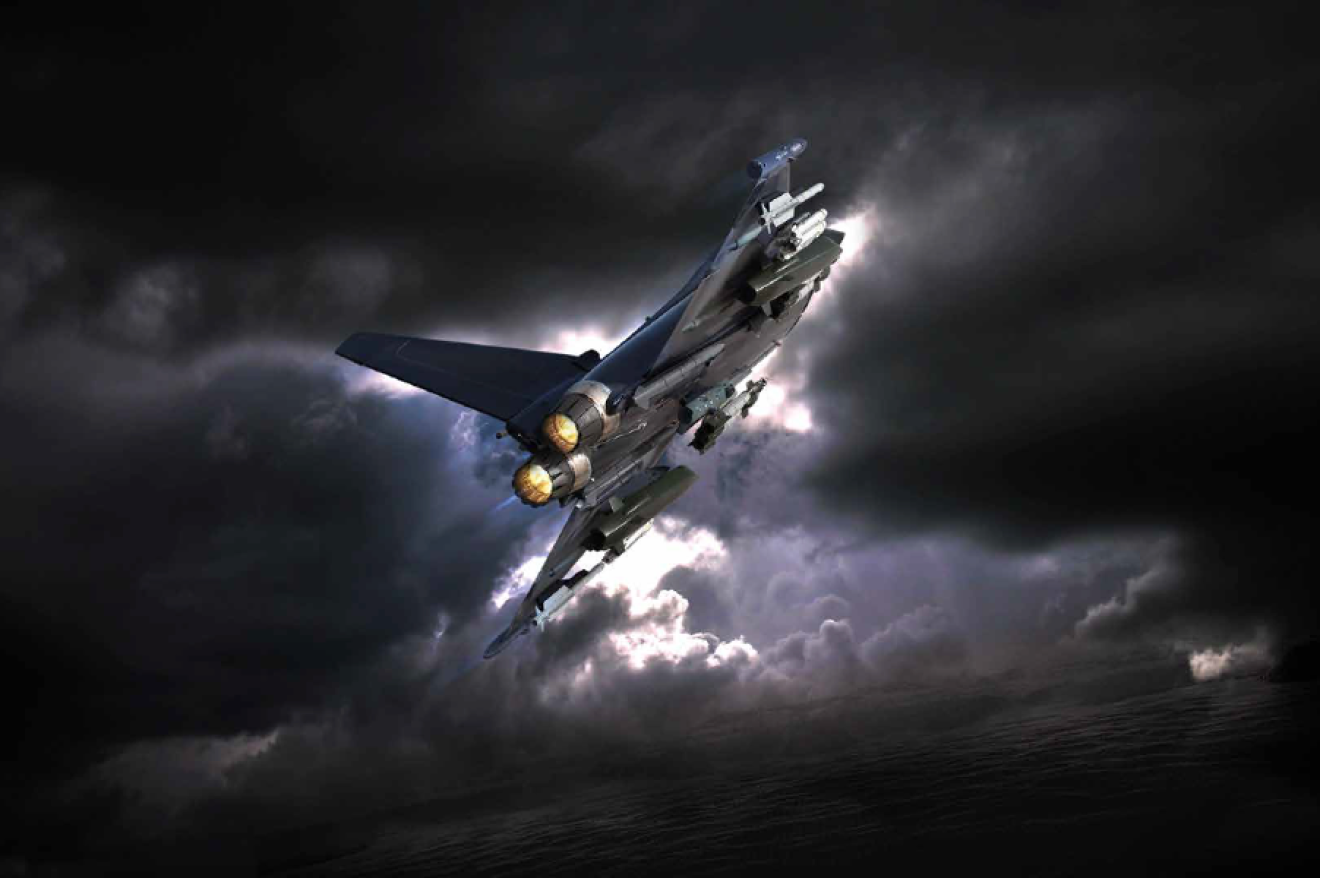Everything changes. Threats mutate and multiply. Technology shifts and data is exploding. The way wars are fought, and territory defended, is altering. And so, the question is, ‘Where does Eurofighter Typhoon fit into this?’
The answer is simple: Eurofighter is constantly evolving too.
More specifically, ideas around a future vision for Typhoon are taking shape and key aspects that can be delivered have started to be identified.
Agreement on an evolved Eurofighter will secure a number of things: the operational sovereignty for European nations, our core engineering minds, and defence industrial base, along with all the economic benefits that brings. With every Euro spent in Europe, the investment stays in the European economy.

In parallel, the evolution of Eurofighter will deliver the best possible technology path towards future air domain security for the region. Additionally, it represents a cost-effective technology route towards FCAS capability, while ensuring evolving 6th-generation system compatibility.
Where are we now?
Right now, Typhoon plays a key role in securing the defence of Europe, with more than 500 aircraft defending the skies over Europe. This is coupled with realistic hopes for more sales, as several European nations are looking at the potential of Typhoon for the defence of their countries and Europe.
Even today Eurofighter is Europe’s largest and most successful defence collaboration programme. It supports more than 100,000 highly-skilled jobs across 400 companies in Europe.
During combat operations like Operation Shader over Syria and Iraq, as well as air policing missions in the Baltics, Eurofighter has proved its operational strengths, with hugely positive feedback from operators. Their opinion is clear and unambiguous. As Eurofighter has climbed up the capability curve, through the addition of weapons like Paveway IV, Storm Shadow, Meteor, Brimstone II, and other elements of a ‘Phased’ enhancement programme, the aircraft has evolved in the right direction.
Looking to the near horizon, the capability roadmap envisages the embodiment of E-Scan radar and the next enhancement, P4E. However, to ensure Eurofighter remains flying and is still relevant into the 2060s, the evolution beyond P4E needs to be mapped out. And that’s what’s taking place now.
Getting to grips with future needs
Even though, from a logical standpoint, we need to continue the Eurofighter evolution journey, no-one can anticipate exactly what might be needed for the 2050s and beyond. This is due to the fact that nobody knows what the threat environment will look like then.
What we do know for certain today is that Eurofighter offers huge growth potential, in terms of connectivity and the ability to fully exploit current and future sensors. Unlocking that potential is key to ensuring that the aircraft stays as relevant in the decades ahead as it is today.
While the detail grows increasingly hazy the further out you project, some of the core characteristics required to retain relevance as threats evolve are already coming clearly into view. These include battlefield awareness, interoperability, connectivity, flexible firepower and cyber-resilience. If that shopping list represents a future commander’s base requirements, the next question is: what are the fundamental enablers that will help transform it from a wish list to a done deal?
From a pilot’s perspective, you’d say that in complex air-to-air and air-to-ground scenarios, you will need 360-degree, time-sensitive battlefield awareness. You’ll need connectivity for tactical operations, decision-making and data/imagery sharing. In addition, with so much reliance on data, you will need incredibly secure cyber-resilience. And, at the end of the day, you will still need to be able to call on flexible and scalable firepower.
Hence, in order to make Eurofighter fit for the future, you have to look at certain enablers — many of these are going to be required in the future on all kinds of assets, not just Eurofighter.
It means boosting the onboard processing capacity to a high level to be able to cope with all the new technology and information that will be gathered by a range of more sophisticated sensors, both on board and elsewhere, like for example, from a forward air controller. It also means having the capability to elaborate on, present and share data. It means having an ability to carry a wide variety of weapons and, often, using them in the same mission.

The way we use those kinetic effects should be scalable. The pilot should be able to choose from the aircraft gun, up to a 2000lb bomb, and be able to release these different weapons in any way he needs.
What does this mean in terms of capabilities?
INFORMATION SUPERIORITY
Let’s start with the end in mind: information superiority. That’s what any pilot or any commander needs in order to hold an advantage over an adversary.
What does that mean? Well, consider this, the air domain will once again become a contested one and there will be increasingly complex operations, featuring a range of connected assets, meaning scenarios become ever more dynamic.
To operate effectively in this new world, you will need information at hand and be in a position to use it first. A prerequisite of this is connectivity.
You need to be able to ‘talk’ and share your information across multiple domains of air, land, sea and space.
You have to have reach back capability, where you communicate with your decision-makers and give them the information needed to make a tactically sound decision. And fast. We are talking seconds.
Information superiority also means having better target fidelity. Quite simply, the more precise the data, the better the weapon effect. And, to get to this point requires data fusion — supplying the pilot in any split second ALL the most relevant information. Easy to say — getting to that state is quite a process.
So, there’s a clear requirement for enhancing Eurofighter’s computing capacity in order to fully exploit the new sensor technology.
Coupled with that, we are also looking at a redesign of the cockpit — again this is in part being driven by a desire to unlock the full potential of new sensors like E-Scan radar. These are essential steps to ensure the Eurofighter’s role as a force multiplier is utilised to the max.
FIREPOWER AND OPERATIONAL FLEXIBILITY
Next up is firepower and operational flexibility. To fulfil a complex task with minimal reaction time you have to be able to maximise and optimise what you have on the jet. Eurofighter already has a very impressive set of weapons but in the future we are also looking into electronic attack and other mission roles. It will offer a much wider and scalable spectrum of effect.
What’s envisaged is a Eurofighter that’s as flexible as possible, one that can carry more and has fewer constraints in terms of its flight envelope. Ultimately, that envisages a future where you are able to hang whatever is needed for a particular mission under each wing.
An increase in the number of missiles on the aircraft is also being looked at. Consider this: a configuration with up to 16 air-to-air missiles and also 14 air- to-surface weapons. That’s fully exploiting the capability of the Eurofighter.
As a pilot I believe there will be a future requirement for an aircraft that just has its boxing gloves on. Yes, it's nice to have a sensor monster, but you need one with a powerful jab too.
This flexibility would also increase a pilot’s fighting time in the battlespace available. To aid this development, ways of increasing fuel loads with new extended range tanks, and more fuel stations, are being looked at.
It would maximise Typhoon’s firepower while still fully exploiting the potential of the aircraft, because what doesn’t change is Eurofighter’s world-beating characteristics — its extreme high thrust-to-weight ratio, its power and its agility.
In short, more weapons, and an ability to carry a greater variety of weapons, means greater operational flexibility. That’s one of the reasons why pilots want to have a Typhoon flying by their side.
Then there are improvements that will extend the lifetime of the aircraft both in terms of flying hours and flying years.
EXPLOITATION OF SENSOR TECHNOLOGY
Other key areas include faster sensor management, self-protection kit and increased battlefield awareness. That means: the introduction of multi-core processing, high speed data network, further exploitation of our Defensive Aids Sub-System (DASS), new cockpit technologies like a larger display, and a new helmet display, Striker 2, which is about to be integrated. We are also looking into the provision for app- based programming of the jet.
The latter means restructuring the mission architecture in order to enable an app- based enhancement. This would potentially open the door for national specialists to programme the jet and give a nation a specific requirement.
This idea of flexibility is being addressed in the planning stage. All of the enhancements are envisaged as scalable options, that the nations might elect to do it or just go for part of this technical solution according to their national requirements.
But it's clear that new sensor technology, like E-Scan radar, will have a high demand on the data network on the aircraft and need processing power to fully exploit them. So a common baseline, including the safety critical items, would have to be agreed.
The processing power and the sensors provide information which drive towards a very increased battlefield awareness. You need a way to display this. In short, to truly exploit new sensors you need a large area display.
Generations
Eurofighter’s evolution is a continuous transition. The jet will be flying and relevant until 2060 and beyond, playing a key role in the future battlespace alongside any future combat air system.
Indeed, a number of technologies ideas and solutions currently being earmarked
for these 6th Gen Combat Systems can be matured on Typhoon and then evolve into a future combat air system. For example, the large area cockpit display. Putting that onto Eurofighter will allow the industry partners to gain experience about how to integrate it and take this knowledge onto a 6th-generation fighter.
Other examples include high-speed data networks and multi-core processing, both key aspects where gaining experience, via Eurofighter embodiment, will have important spin-offs for bringing those features to a future system.
A Common Core with Inbuilt Flexibility
While there is an emerging common thread of national requirements, each national
air force might also have its own specific needs. That’s normal and Eurofighter has proven to be flexible in the past, being one of its biggest strenghts.
It’s therefore important that any enhancements that go onto the aircraft are as scalable as possible. Initially, nations will agree a common baseline and they are currently making progress on this. Part of the thinking behind the current evolution study is to identify the common development threads and examine how these can be scaled.
There’s a high degree of interdependency here too. For example, the arrival of an E-Scan will give the pilot more accurate target data, hence a better employment of the weapons. However, to carry all the weapon configurations, an aerodynamic modification kit could be wanted or, even, needed
FACTS AND FIGURES:
623 aircraft ordered – Europe’s largest military collaborative programme
More than 580,000 flying hours achieved
97% mission availability during Unified Protector 2011 (Libya)
99.4% mission availability during Baltic Air Policing 2015
Current deployment over Baltics and Middle East
Over 300 yearly flying hours per jet
Eurofighter is the backbone of NATO Quick Reaction Alert over Europe
Combat-proven during operations over Libya, Syria and Iraq
More than 10,000 hours flown, over 800 precision-guided ammunition dropped in missions, during operation Shader by UK RAF
